Setting the correct specification
|
OEM reported catastrophic failure in their equipment
Diagnosed as filter blocking
Cause was gel formation as a result of acidic lube components reacting with yellow metals
Additive supplier had changed their process without informing the customer
TAN had never been part of the sales specification |
Our client had a well-established industrial lubricant which was recommended by an influential OEM. After many years of good service, the OEM and the client suddenly received multiple customer complaints about catastrophic failure of the equipment in service. The failure was rapidly diagnosed as being due to filter blocking and the cause appeared to be a gel containing copper and zinc.
The lubricant was ashless, so the metals were coming from the yellow metal components of the equipment. Within days the customers had established that the batches of lubricant in the field had TAN values of several mgKOH/g and sometimes in excess of 10 mgKOH/g.
The equipment had always contained yellow metals, so the client knew that they should be selling a product that had a near-zero TAN. Yet TAN was not part of their sales specification or their blend quality controls. The OEM was angry and threatened to sue.
This is where we came in, advising to test the raw materials as well as investigate any possible sources of contamination in or downstream of the blending process.
The client tested the TAN on their retained samples and found it in agreement with field samples. What had changed? One of the components had a high TAN, but it was otherwise in specification and TAN was not part of the purchase specification.
Fortunately for the client, they used to rigorously test all additives in their R&D programme. Old lab books were recovered from archive and they could show that all development samples had had a TAN on the additive of below 1 mgKOH/g. The treat rate of this additive was below 1%.
This information gave them leverage against the additive supplier that something had changed. The additive supplier admitted that they had changed their process and conceded that they should have informed their customer. The supplier modified their process (or reverted to the old process) and a new sales specification was agreed for the additive that included a tight TAN maximum in line with the samples that had been received by the client many years earlier. While most of the OEM-related business was saved, it was at the expense of committing to report sulfated ash and TAN on every certificate of analysis.
Learning Points
|



